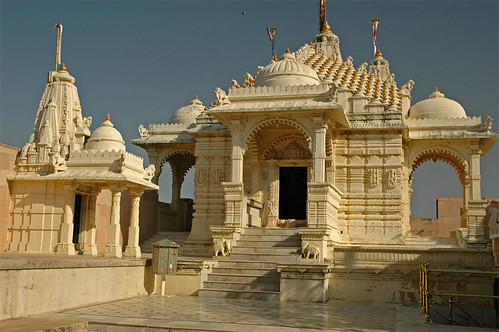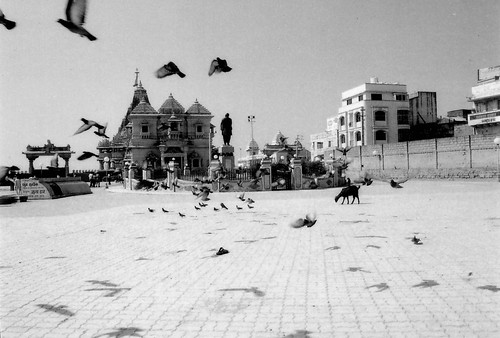Nageshwar Mandir is a Lord Shiva temple, and Nageshwar Jyotirlinga is believed to protect devotees from all poisons. There are many legends about Nageshwar. One of them is related to Daruka who lived with her community of demons in the forests near Dwaraka. The demons used to harass sages and they approached an enlightened sage Orvamuni. He cursed the demons for their destruction, and a war between the gods on demons followed.
To save the demons, Daruka used her special powers (boon) she had got from goddess Parvati and shifted the entire forest to the sea. From there they continued troubling the sages and once they captured the Shiva devotee Supriya, who made all other captives recite the powerful Om Namah Shivaya mantra of Lord Shiva. But when the demons decided to kill Supriya, it disturbed the Shiva-Parvati devotee Daruka. She prayed to Lord Shiva who appeared here and freed all from the demons. But Parvati granted a boon to Daruka that she would rule the region. Lord Shiva agreed to this and with Parvati stayed there, Shiva assuming the form of Jyotirlinga with the name Nageshwar and Parvati becoming Nageshwari.
According to Hindu scriptures, King Yadu of Yadu dynasty was married to a Nag girl. Skanda Purana mentions that the King Raivat of Kushsthali was an incarnation of Takshak Nag. Often Dwaraka is also named as Kushsthali in Hindu scriptures. Some historians think that the Aryans made the Nags a religious community and established Nageshwar Jyotirlinga.
The present temple was renovated by Late Gulshan Kumar, starting the work in 1996, before his assassination. The entire project cost of Rs 1.25 crores was born by Gulshan Kumar Charitable Trust.
Nageshwar Temple is visible from a distance of 2 km. A huge 125 feet high and 25 feet broad attractive statue of Lord Shiva in meditation pose greets devotees from outside the main temple. At the main entrance is a hall or Sabha Mandap. The main Jyotirlinga is situated under the Sabha Mandap floor, with a silver replica of Nag (snake) placed there. Behind the Jyotirlinga there is an idol of Goddess Parvati. Only male devotees wearing dhoti can enter and perform pooja/prayers at the Garbhagriha.
The morning Arti begins at 5 AM and the temple opens for devotees from 6 AM. Devotees can have a Sringar Darshan at 4 PM, after which entry to Garbhagriha for devotees is closed, though the rest of the temple closes only at 9 PM. During Holy Shravan, Navaratri, Diwali, Kartik Purnima and Mahashivaratri the temple remains open for longer hours.
The best time to visit is from August to September. The nearest (146 km) airport is Jamnagar. Nageshwar is situated between Okha (14 km) and Dwaraka (16 km). Visitors have to stay either at Dwaraka or Okha from where buses and taxis are easily available. Nageshwar is also on the circuit of Dwaraka Darshan tours of local tourist bus services. For nominal rates, Dwaraka Darshan offers a sight-seeing trip of five to six hours covering Nageshwar Jyotirlinga, Gopi Talav, Bet Dwaraka, Rukmini Temple.
The distance between Dwaraka and Nageshwar is only 16 km. Dwaraka, the ancient capital of Lord Krishna, is well connected with the other parts of India by railways, with more than seven long distance trains and many shorter distance trains. There are regular Government Transport buses and private buses between Ahmedabad and Dwaraka, taking nine to ten hours to reach Dwaraka. Night buses and sleeper coaches are also available.
Okha is the last stop for Dwaraka on railways and road routes. The distance between Dwaraka and Okha is 30 km. Distance from Dwaraka: by train to Ahmedabad = 471 km, Vadodara = 571 km, Surat = 700 km, Vapi = 798 km, Mumbai (Bandra) = 962 km, Puri = 2752 km, Jammu Tavi = 2154 km. Distance from Dwaraka by road to Ahmedabad = 457 km, Somnath = 230 km, Rajkot = 232 km, and Jamnagar = 144 km.
Many visitors prefer the Dwaraka-Porbandar-Somnath route, on the coastal road famous for its scenic beauty. Porbandar, the birth place of Mahatma Gandhi, is 75 km from Dwaraka. Devotees first visit Harsiddhi Mataji Temple (Harshad Mataji Temple) on seashore before Porbandar. Somnath is about 150 km from Porbandar. Private buses start from Dwaraka at 8 AM in the morning and reach Somnath at 2 PM covering Mool Dwaraka and Harsiddhi Mataji temple.
Dwaraka city has all the basic amenities for tourists and devotees. Power cut is rare. There are good hotels, guest houses and even community living accommodation (dharmashalas) at cheap/affordable rates. Food in North Indian, South Indian, Gujarati, Rajasthani and even Chinese styles are available in most eateries, including hotels and restaurants.





